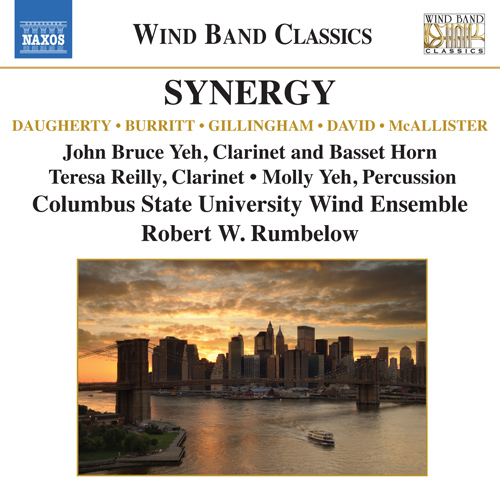I understand why this is issued under the Naxos Wind Band series, but it’s almost a recital disc for the truly excellent John Bruce Yeh. A member of the Chicago Symphony Orchestra, he plays on all the pieces except the Gillingham. The program follows an arch progression from solo to duet to quartet and back again. All told, it’s a very satisfying progression—bravo to whoever designed it.
The repertoire itself is mostly excellent—the McAllister may be a bit too long, and I wasn’t fully convinced by the Stravinskyesque touches of the David, though it has grown on me. But all the works have their charms, and the Daugherty is a wonderful surprise, the best work of his I’ve heard. The first movement opens the disc in tremendously convincing fashion, drawing the listener in for the full length of the work. The second movement accesses a tenderness and harmonic sensitivity I didn’t give Daugherty credit for. The fourth movement is a witty romp that doesn’t feel disposable the way this type of music sometimes can. The Burritt is also very accessible, in a standard fast-slow-fast shape and filled with memorable melodies and colors. I hope it has more of a life outside of this disc! The percussion soloist is Yeh’s daughter, and she was in high school when she recorded this remarkable performance. Yeh’s wife joins him on the David, where she also plays extremely well—what a family! Finally, the Gillingham is another excellent, colorful work which has already found a place in the repertoire. Moving steadily from a place of stillness and suspense to one of dramatic declamation, it is playable by an excellent amateur group but doesn’t feel like a “compromised” work at all. This performance cleanses the palette effectively for the rest of the disc yet also feels very much of a piece with the rest of the program.
Then there are the performances. Yeh dominates the disc, and completely inhabits these pieces, making each performance feel definitive. He’s a fabulous player who deserves this level of exposure. As for the band, their performances are thrilling, extremely precise and well rehearsed while still being very musical—there’s a palpable sense that everybody cares about every note. It’s a balancing act few wind bands seem to be able to achieve on recordings, with too many erring on the side of precise-but-not-musical—an understandable but regrettable error. On this disc, there’s a real sense of communication from composer, through ensemble, to listener. Congratulations and appreciation to everyone involved with this project for achieving it.
A showcase for the virtuosity of the principal clarinetist of the Chicago Symphony Orchestra, John Bruce Yeh. Four works composed in the 21st century that come from American composers working in a listener-friendly world that has easy access to concert audiences. Michael Daugherty’s clarinet ‘concerto’, Brooklyn Bridge, is a group of four Manhatten pictures that take the instrument from the brazen sounds of Brooklyn and Brooklyn Heights, to the creamy tones that open the Statue of Liberty. With just a few ‘tricks of the trade’, and a wind orchestra that enters into a brilliant partnership, the work drives through to its hectic finale. Michael Burritt’s Duo Concertante brings on stage his young percussionist daughter, Molly, her part mainly given to a display of agility on the marimba. That instrument runs through into David Gillingham’s Concertino for Four Percussionists and Wind Ensemble dating from 1997, a quiet opening eventually giving way to feverish activity. Then it is the turn of his highly regarded clarinetist wife, Teresa Reilly, who shares the solo spot with him in the Second Book of David’s Fantasy Etudes, Yeh moving to Basset Horn. The composer’s stated debt to Ligeti is plain to hear, but it is early rather than late Ligeti, its four short movements having sufficient to protect the sanity of conventionalists. Finally to Scott McAllister’s Black Dog, another piece ideal for Yeh’s prodigious dexterity as the instrument takes on the role of a singer in a hard rock band. The playing of the Columbus ensemble is most impressive and on a par with the best professional groups. The recorded sound is punchy, close up and well suited to such high octane works.

































